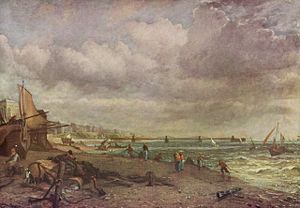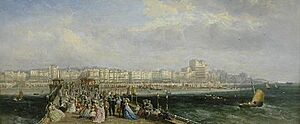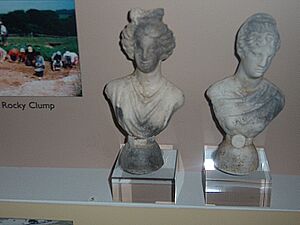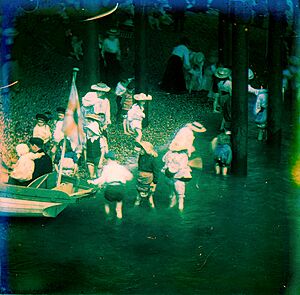History of Brighton facts for kids
The history of Brighton tells the story of an old fishing village that became a popular health resort in the 1700s. By the 1900s, it had grown into one of the biggest towns in England.
Contents
What's in a Name?
The name Brighton comes from an old English name, Beorhthelmes tūn, which means "Beorhthelm's farmstead." Over many years, this name changed. It was called Bristelmestune in 1086, then Brighthelmeston in 1493, and Brighthemston in 1610. The name Brighton became common in the early 1800s.
Ancient Times
Stone Age Discoveries
At Black Rock, near Brighton Marina, you can see special rocks called "Elephant Beds." These rocks show where an ancient beach was 200,000 years ago. Early humans, like those found in the Neander Valley, hunted large animals such as mammoths along this old coastline. This area is now protected because it shows us so much about the past. You can find this spot behind the Asda supermarket car park.
Early Farming Communities
Whitehawk Camp is an ancient site from around 3500 BC. It was a large, circular area with ditches and mounds, built by early farmers. Archaeologists have found four circles of ditches there. You can still see parts of these mounds today.
Another ancient site is The Goldstone, located north of Old Shoreham Road. People believe this stone was used for special ceremonies. Some think it was part of an old stone circle. A local farmer buried the largest stone in the early 1800s because tourists kept visiting it, but it was dug up again in 1900.
Bronze Age and Iron Age Life
During the Bronze Age, around Brighton, archaeologists have found special burials from the Beaker culture. These graves often contained valuable items.
An important site from the Iron Age (before the Romans) is Hollingbury Castle (also called Hollingbury Hillfort). This ancient Celtic camp has large earth walls and offers amazing views over the city. It's one of many hillforts found across southern Britain.
Roman Times
The Romans built villas all over Sussex, including one in Brighton. This villa was built in the late 1st or 2nd century AD near what is now Preston Park. It was excavated in the 1930s.
At the Brighton museum, you can see two Roman figures found at this villa. Also, Rocky Clump in Stanmer Park was a Roman-British farming settlement.
A Roman road connected Shoreham-by-Sea to Brighton and then went north to Hassocks, which was a Roman industrial area. While no big Roman town has been found in Brighton, many Roman objects have been discovered. This suggests there might have been a settlement that is now buried or was washed away by the sea.
After the Romans left Britain in AD 410, Saxon raiders began to attack the coast.
Middle Ages
Anglo-Saxon Brighton
After the Roman Empire fell in the 400s, Saxons settled in the Brighton area. This region became part of the Kingdom of Sussex. Around 827, Sussex joined the Kingdom of Wessex, which later became the Kingdom of England. The name Brighton, meaning "Beorhthelm's farm," comes from this time. A Saxon burial ground from the 500s-600s has been found near the Seven Dials area.
Brighton started as a place where boats could land, especially for fishing. In 1086, the Domesday Book recorded that one area paid rent with 4,000 herrings! At the end of the Saxon period, Earl Godwin, a powerful earl and father of King Harold, owned land in Brighton.
Norman Conquest and Early Town Life
After the Norman Conquest, King William I gave the area of Lewes to his son-in-law, William de Warenne. The Domesday Book of 1086 is the first written record of Brighton, calling it Bristelmestune.
Brighton likely became a town by the 1100s. Between 1120 and 1147, monks from St Pancras Priory built St Bartholomew's Priory where the town hall is now. The old parish church of St Nicholas also has a beautiful 12th-century font, showing it was built around that time.
Two elm trees at Preston Manor are thought to be the oldest English elms in the world, dating back to the mid-1100s.
1300s Brighton
The town's layout, with its regular streets, suggests Brighton was planned around 1300. In 1312, King Edward II gave Brighton the right to hold a market and an annual fair.
St Peter's Church at Preston Village, Brighton dates from the 1300s. A medieval painting showing the murder of Thomas Becket was found there, making it one of Brighton's oldest artworks.
Early Modern Brighton
In June 1514, the French burned down the fishing village, then known as Brighthelmstone, during a war. Later, in 1545, the town's residents asked the king for cannons to defend themselves. Their request included a map showing the French raid, which you can see a copy of in Hove Museum. This map is the oldest known picture of Brighton.
It shows the town laid out in a rectangle. The lower town, with houses on the beach, suffered from sea erosion. By 1665, many houses were gone or in poor condition. However, by the 1640s, Brighthelmstone had over 4,000 people and was the largest settlement in Sussex, with fishing as its main industry.
Dirick Carver, a brewer on Black Lion Street, was arrested for his religious beliefs. He was later executed in Lewes.
After his defeat at the Battle of Worcester, King Charles II escaped to France through Brighton and Shoreham-by-Sea. This event is still remembered today with the Royal Escape yacht race. The tomb of Nicholas Tettersell, the boat owner who helped Charles II escape, is in St Nicholas churchyard.
Brighton's Rise as a Resort
Decline and Rebirth in the 1700s
After a good period in the 1600s, Brighton slowly declined in the 1700s. This was due to less demand for fish and damage from the sea. The Great Storm of 1703 caused a lot of damage. Another storm in 1705 destroyed the lower town. By the mid-1700s, Brighton's population had dropped to 2,000 people.
Then, in the 1730s, Dr. Richard Russell from Lewes started telling his patients to use seawater for their health. He wrote a book in 1750 saying that drinking seawater and sea bathing were good for you. In 1753, he built a large house for himself and his patients.
Other doctors, like Dr. John Awsiter and Anthony Relhan, also promoted the health benefits of Brighton's waters. This led to more interest in the town.
Royal Visits and Growth
After Dr. Russell died in 1759, his house was rented to important visitors, including the Duke of Cumberland (King George III's brother) in 1771. On September 7, 1783, the Prince of Wales (who later became King George IV) visited his uncle. The Prince loved Brighton and visited it often for the next 40 years. His visits helped Brighton grow from a fishing village into a famous modern town.
Marlborough House on the Old Steine was built in 1765. By 1780, the beautiful Georgian buildings that Brighton is known for began to appear. The town quickly became a fashionable resort. In 1786, the Prince of Wales rented a farmhouse and spent a lot of time in Brighton. He built the amazing Royal Pavilion, which is now Brighton's most famous landmark.
A military base, Preston Barracks, was built in 1793.

The Kemp Town area, with its beautiful Regency architecture, was built between 1823 and 1855.
The 1800s and Early 1900s
Brighton continued to be popular with wealthy and famous people in the 1800s. Many grand hotels were built along the seafront, like the Bedford Hotel (1829), the Grand Hotel (1864), and the Metropole Hotel (1890).
The Royal Pavilion was a key reason for Brighton's popularity. Its amazing design, expanded by John Nash starting in 1811, made Brighton a center for high society.
Gideon Algernon Mantell, a scientist who identified the iguanadon from a fossil tooth found nearby, lived in Brighton in the early 1800s. He was one of the first to suggest that giant lizards ruled the Earth long ago.

Brighton became important for railways after the Brighton railway works were built in 1840. This made it easy for day-trippers from London to visit. In 1845, Queen Victoria moved out of the Royal Pavilion and sold it to the town of Brighton in 1850.
The Brighton School of Art was founded in 1859. It later became part of the University of Brighton.
Many churches were built in Brighton in the late 1800s, thanks to Reverend Arthur Douglas Wagner. These include St. Bartholomew's, a large red brick building, and the Parish Church of St. Michael and All Angels, which has beautiful stained glass windows by famous artists.
In the early 1900s, Otto Pfenninger developed one of the first ways to take color photographs in Brighton's parks and on its beaches.
First World War Impact
During the First World War (1914-1918), the Royal Pavilion was used as a military hospital for Indian soldiers. It treated over 4,300 patients. Later, it became a hospital for soldiers who had lost limbs. Other schools and buildings in Brighton were also used as hospitals. Brighton was even the site of the first hospital in Britain for soldiers suffering from shell shock.
The sound of guns from the Battle of the Somme in France could be heard in Brighton in June 1916.
The Brighton War Memorial in Old Steine, unveiled in 1922, lists the names of 2,597 men and 3 women from the town who died in the war.
The Chattri is a memorial on the Downs, north of Patcham. It honors the Indian soldiers who died at the Royal Pavilion hospital. It's an octagonal monument built where Hindu and Sikh soldiers were cremated.
After the Wars
Brighton's growth after the wars continued its reputation as a fashionable place. More tourists meant more businesses like pubs and restaurants. A big development was the founding of the University of Sussex in 1961, designed by Sir Basil Spence. This university became known for its strong academics. Brighton also has the University of Brighton, which started as the Brighton School of Art.
Some areas of Brighton changed a lot after the war, with new buildings for local housing. For example, Richmond Street was largely replaced by tower blocks.
In the 1970s, the North Laine area was almost torn down, but it was saved thanks to a planning officer named Ken Fines.
The 1970s and 1980s saw some parts of Brighton become run-down. However, a major project, the Brighton Marina, was built, though many local people were against it. The seafront was less developed than it is today.
A big natural event happened in 1987: the Great Storm. Many large elm trees were lost at The Level and Steine. The Pavilion and the Church of St. Peter were also damaged.
Embassy Court, a unique building on the seafront, was built in 1935. By the 1990s, it was in bad shape, with parts falling off. But residents worked together to save it, and it was restored by 2005.
In 1997, Brighton's town council became part of Brighton and Hove, which was granted city status by the Queen in 2001.
Brighton's Economy Through Time
For its first 700 years, fishing was the most important part of Brighton's economy. Areas like the Hempshares (now The Lanes) provided hemp for ropes. Fishermen lived and worked on the beach below the East Cliff, in an area called Lower Town. Herring and mackerel were very important. In 1579, a special group was formed to write down how fishermen worked and shared their catches. This became law. In 1580, Brighton's fishing fleet was the largest in southern England, with 80 boats and 400 men. While herring and mackerel were main catches, plaice, cod, and conger eels were also fished. The fishing industry slowly declined over time. Today, a much smaller fleet is based at Brighton Marina.
In the 1700s, Brighton's economy grew and changed. Small factories were set up, especially in the North Laine area. Coal importers brought fuel from Newcastle. With the rise of tourism, many people opened lodging houses, schools, and shops for clothes and jewelry. Many women worked, often running lodging houses or working in laundries.
Brewing was another important industry. It started in the 1600s and grew after 1800. Big breweries included Kemp Town Brewery and Tamplins. The Black Lion Brewery, founded by Dirick Carver in 1545, stopped brewing in 1901. Tamplins was the biggest, owning over 200 pubs in Brighton at one time.
Community and Activism
Brighton has a history of community action. The political group Justice? and its newspaper SchNEWS were based in Brighton. They were at the Cowley Club, a social center named after Harry Cowley, who was known for his "people power" activism in Brighton.
See also




